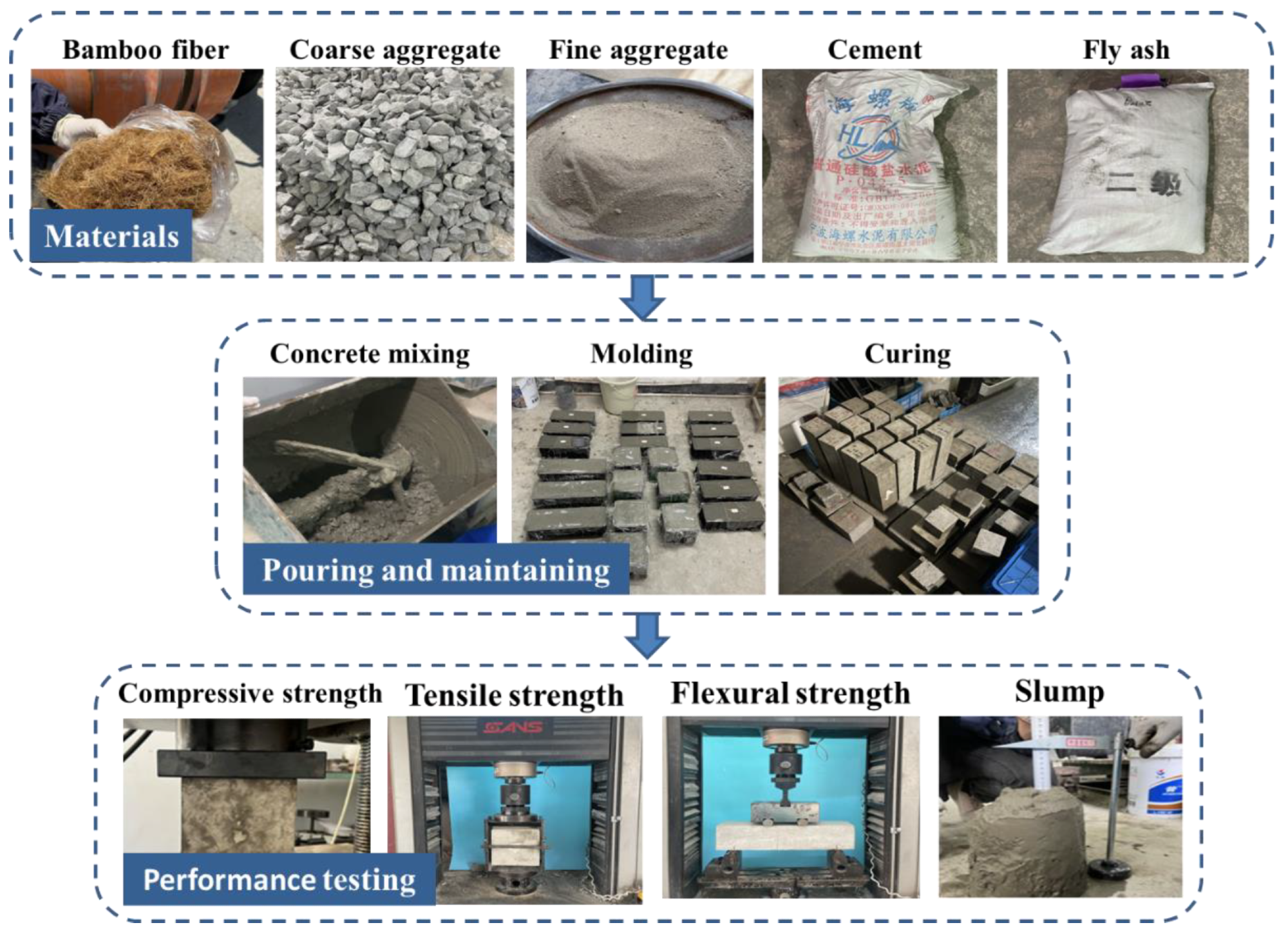 By Nidhi DhullReviewed by Susha Cheriyedath, M.Sc.Jun 27 2024
By Nidhi DhullReviewed by Susha Cheriyedath, M.Sc.Jun 27 2024A recent article published in Materials explored the properties of concrete synthesized using natural bamboo fibers (NBFs) and recycled aggregate from crushed waste concrete. The study utilized an orthogonal experiment to identify the optimal mixing proportions for NBF-reinforced concrete.
 Casting and property testing of NBF-reinforced concrete specimens. Image Credit: https://www.mdpi.com/1996-1944/17/12/2972
Casting and property testing of NBF-reinforced concrete specimens. Image Credit: https://www.mdpi.com/1996-1944/17/12/2972
Background
Reusing recycled aggregates from waste concrete is a crucial method for managing construction waste. However, recycled aggregates exhibit increased porosity and water absorption, resulting in inferior structural properties compared to natural aggregates.
Incorporating fibers into recycled concrete can partially overcome these limitations by enhancing toughness and crack resistance. Typically, steel and polypropylene fibers are used for this purpose. However, there is a growing demand for high-performance natural fibers that offer a low carbon footprint and biodegradability.
Bamboo, an abundant natural resource available globally, provides energy-saving benefits with its short growth cycle and minimal energy requirements for harvesting and processing. Additionally, natural bamboo fibers (NBFs) possess a high specific modulus and strength, contributing to reduced carbon emissions in the construction sector when used in building materials.
Despite these advantages, NBFs face certain challenges in concrete applications, such as insufficient bonding, low hydrophilicity, and vulnerability to biodegradation. This study, therefore, examined the impact of fiber admixture on the workability and mechanical properties of concrete in detail.
Methods
The raw materials used for producing concrete included Portland cement, fly ash, recycled aggregate from a recycled resource utilization company, desalinated sea sand as the fine aggregate, and tap water. Additionally, natural bamboo fibers (NBFs) produced from Moso bamboo were commercially procured.
Before casting the concrete, the NBFs were pretreated by carding and cut into various lengths. The quality grade of the recycled aggregate was assessed, and its particle size distribution was optimized for concrete preparation.
The mixing ratios for NBF-reinforced concrete were determined according to the Specification for Mix Proportion Design of Ordinary Concrete. Following preliminary design, trial mixing, and adjustments, the final concrete mix with varying water-cement ratios was prepared.
The workability of the concrete was assessed using the slump cylinder method. The compressive strength and cubic split tensile strength of the NBF-reinforced concrete were measured using a universal testing machine after 28 days of curing, with specimens measuring 150×150×150 mm³.
Additionally, the prismatic flexural strength of the NBF-reinforced concrete was tested using samples measuring 100×100×400 mm³. Scanning electron microscopy (SEM) was employed to observe the morphology of the prepared concrete samples and to identify and analyze the hydration products.
An orthogonal experiment was designed with the NBF length, NBF content, and water-to-cement ratio as variables. The test results were evaluated using range analysis to determine the optimal ratios of each variable. Variance analysis from repeated tests was used to analyze the significance of each factor.
Results and Discussion
The experimental results revealed enhanced mechanical strength of the NBF-reinforced recycled aggregate concrete fabricated according to optimal parameters obtained from the orthogonal experiment. These included a 20 mm fiber length (from 10 mm, 15 mm, and 20 mm lengths), a 0.4 v% (volume%) fiber content (from 0.2 v%, 0.3 v%, and 0.4 v%), and a 0.55 water-to-cement ratio (from 0.55, 0.60, and 0.65 ratios).
The mechanical properties and workability of the prepared concrete were primarily influenced by the fiber content and water-to-cement ratio, with the fiber length having a relatively minor effect.
The optimum average compressive strength of NBF-reinforced concrete was 25.2 MPa, 7.3 % higher than that of the concrete without NBF (23.4 MPa). NBFs enhanced the toughening and crack resistance of the concrete, thereby improving its resistance to brittleness.
The primary failure mechanism of NBF-reinforced concrete under compression was the outward development of the complete surface mortar layer, with the fibers efficiently holding the concrete together. Overall, the concrete samples demonstrated fair integrity after failure, sustaining their entire form without localized collapse.
Furthermore, SEM analysis revealed minimal flaky Ca(OH)2 crystals at the NBF-hardened cement paste interface. The hydration products mainly comprised needle-shaped ettringite and calcium-silicate-hydrate gel. These products enhanced the structural density and facilitated strong bonding at the NBF-hardened cement interface.
Conclusion
Overall, the sustainable and cost-effective NBF-incorporated recycled concrete developed in this study exhibited enhanced mechanical properties. The orthogonal experiment helped examine the effect of NBF content, NBF length, and the water-to-cement ratio on the concrete’s workability, compressive strength, splitting tensile strength, and flexural strength.
The researchers exclusively focused on the nature and distribution of hydration products in NBF-incorporated cement-based materials using SEM. They plan to integrate X-ray diffraction and Fourier transform spectroscopy techniques in the future for a more comprehensive and rigorous investigation of the micro-mechanisms of materials.
This study can provide a reference for innovative approaches to construction waste reuse and adopting low-carbon biomass fibers. Ultimately, this can accelerate the utilization of environmentally friendly and sustainable building materials.
Journal Reference
Xu, B., Tian, R., Wang, Y., Zhang, Z., & Zhang, Z. (2024). Preparation and Properties of Natural Bamboo Fiber-Reinforced Recycled Aggregate Concrete. Materials, 17(12), 2972. DOI: 10.3390/ma17122972, https://www.mdpi.com/1996-1944/17/12/2972
Disclaimer: The views expressed here are those of the author expressed in their private capacity and do not necessarily represent the views of AZoM.com Limited T/A AZoNetwork the owner and operator of this website. This disclaimer forms part of the Terms and conditions of use of this website.